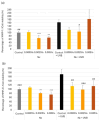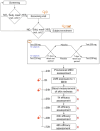Skin Photoprotection and Anti-Aging Benefits of a Combination of Rosemary and Grapefruit Extracts: Evidence from In Vitro Models and Human Study
- PMID: 40362239
- PMCID: PMC12071866
- DOI: 10.3390/ijms26094001
Skin Photoprotection and Anti-Aging Benefits of a Combination of Rosemary and Grapefruit Extracts: Evidence from In Vitro Models and Human Study
Abstract
Skin exposure to ultraviolet radiation (UVR) causes oxidative stress, inflammation, and collagen degradation and can trigger erythema. While topical formulas protect the skin from UV damage, there is growing evidence that certain botanical ingredients taken orally may have an added benefit. This study evaluated the photoprotective, anti-photoaging, and anti-erythema efficacy of a combination of rosemary and grapefruit extract (Nutroxsun®). Radical oxygen species (ROS) generation and interleukin production were determined in UV-irradiated keratinocytes (HaCaT). Also, collagen and elastin secretion and metalloproteinase (MMP-1 and MMP-3) content were assessed in UV-irradiated fibroblasts (NHDFs). Furthermore, a placebo-controlled, randomized, crossover study was conducted in 20 subjects (phototypes I to III) receiving two doses, 100 and 200 mg, of the ingredient. Skin redness (a* value, CIELab) after exposure to one minimal erythemal dose of UVR was assessed. As a result, the botanical blend significantly attenuated the UVR-induced reductions of procollagen I and elastin and lowered MMP-1 and MMP-3 protein secretion. Also, a reduction in ROS and proinflammatory interleukins (IL-1, IL-8, and IL-6) was observed. Finally, the botanical blend, at both doses, significantly reduced UV-induced erythema reaction from the first day of intake and accelerated recovery. These findings reinforce the potential of this ingredient as an effective dietary solution to protect the skin against UV-induced damage.
Keywords: Citrus paradisi; Rosmarinus officinalis; collagen; dietary supplement; elastin; erythema; metalloproteinases and clinical study; photoaging; photoprotection.
Conflict of interest statement
N.C., J.J., A.G. and P.N. belong to the Research and Development Department at Monteloeder S.L. This does not alter the author’s adherence to all the journal policies on sharing data and materials.
Figures






 product intake. Statistically significant vs. placebo is reported as * p < 0.05 and ** p < 0.01.
product intake. Statistically significant vs. placebo is reported as * p < 0.05 and ** p < 0.01.
 information,
information,  physical examination,
physical examination,  informed consent signature,
informed consent signature,  eligibility check,
eligibility check,  randomization, R skin redness,
randomization, R skin redness,  product intake.
product intake.References
Publication types
MeSH terms
Substances
LinkOut - more resources
Full Text Sources
Medical
Research Materials
Miscellaneous

